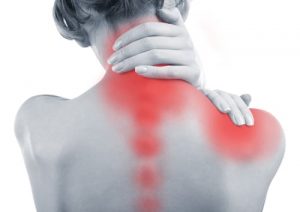
Chronic pain in the neck and shoulder can be debilitating. From muscle spasms and osteoarthritis to thoracic or cervical spine sprain, it can limit movement and cause individuals to retreat from everyday activities. Surgery is invasive, with complications, side effects, and long recovery periods that can sideline people from their lives for months. Results cannot be guaranteed, so the benefits may not make it worth the expense and possible outcomes. Low-level laser light therapy, also known as Cold Laser Therapy, may offer a noninvasive option for reducing chronic neck and shoulder pain.
What Is Cold Laser Therapy?
Cold laser therapy uses a handheld instrument to precisely focus specific light wavelengths to treat tissue. It has a photochemical effect similar to that of photosynthesis in plants and trees. Using the correct density of wavelength and light for an appropriate amount of time, often 30 to 60 seconds, prompts healing. A continuous beam can help achieve pain relief while pulsing light elicits an anti-inflammatory effect and tissue repair.
What Are the Benefits of Cold Laser Therapy?
Treatment with low-level laser therapy may be an alternative to medication or surgery. The most highly reported benefits include:
Rapid cell growth as the laser speeds cellular reproduction
Faster healing as fibroblast development is stimulated
Heightened metabolic activity increases oxygen to blood cells, which promotes a more effective immune response
Reduced scar tissue formation when compared to invasive procedures
Reduced swelling, improving joint mobility
Stimulated blood circulation, encouraging the affected tissue to regenerate
Faster nerve cell reconnection to optimize muscle action
Which Conditions Can Be Treated With Cold Laser Therapy?
Cartilage, ligament, muscle, and nerve cells can be stimulated with this type of therapy. As a result, several conditions can be treated with positive effects:
Neck pain
Fibromyalgia
Back pain
Tendonitis
Arthritis
Knee pain
Carpal tunnel syndrome
The main reason for using low-level light therapy is tissue repair and pain relief. Although treating chronic pain may be the most prevalent use, medical professionals use this therapy in a variety of ways:
Physical therapy and sports medicine utilize low-level light therapy to reduce swelling and promote healing for sprains and joint strains.
Physicians can treat inflammation caused by chronic autoimmune diseases and arthritis.
Dentists can use these techniques to heal ulceration.
Dermatologists may use cold laser therapy to address issues such as edema, rashes, ulcers, and burns.
Acupuncturists can use LLLT to stimulate acupoints instead of needles.
Is Cold Laser Therapy the Right Option?
Cold laser therapy has been proven to offer pain relief and improve healing in tissue for a variety of conditions and maladies. There is generally no need for medications or special preparation. This may make it a preferred treatment for those who prefer not to use drugs or take the risks often associated with surgery. Consulting with a medical professional can help patients decide if cold laser therapy is right for them.
Experienced, qualified practitioners can explain the benefits as well as the downsides of treating specific types of conditions. Each patient’s experience is unique. Although many may experience positive results after one session, a series of treatments may be necessary to measure the therapy’s overall level of success.









